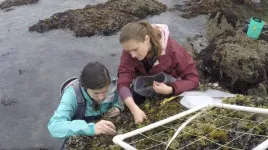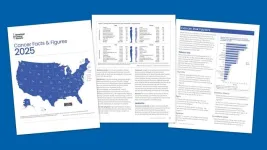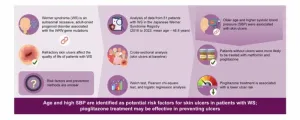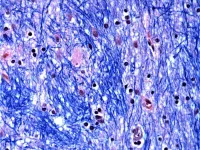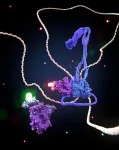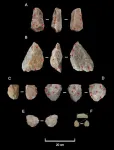(Press-News.org) A mussel bed along Northern California’s Dillon Beach is as healthy and biodiverse as it was about 80 years ago, when two young students surveyed it shortly before Pearl Harbor was attacked and one was sent to fight in World War II.
Their unpublished, typewritten manuscript sat in the UC Davis Bodega Marine Laboratory’s library for years until UC Davis scientists found it and decided to resurvey the exact same mussel bed with the old paper’s meticulous photos and maps directing their way.
The new findings, published in the journal Scientific Reports, document a thriving mussel bed community that nonetheless shows the mark of climate change. Ninety species of invertebrates were found to live within the mussel bed — slightly more than those found in 1941. Among them were warm-adapted species more typically found in southern waters, such as the California horsemussel Modiolus carpenteri and the chiton Mopalia lionota.
“We anticipated finding dramatic losses of species,” said lead author Emily Longman, who conducted the study as a UC Davis graduate student and is currently a postdoctoral fellow at the University of Vermont. “We predicted we’d have a big decline in biodiversity. Shockingly, we didn’t find that. If anything, we found more species. This mussel bed community is really healthy.”
Living author
Adding to their excitement, the researchers learned after completing their survey that one of the old manuscript’s authors, Milton Hildebrand, was not only still alive at age 101, but living in nearby Davis as a retired UC Davis zoology professor. Longman and Sanford got to meet with the WWII veteran in 2019 before his death the following year.
“Transferring scientific knowledge across generations like this is more than just the numbers and data — it’s a very human endeavor,” said senior author Eric Sanford, a professor with Bodega Marine Laboratory in the UC Davis Department of Evolution and Ecology. “Watching Emily Longman, a graduate student, interact with this 101-year-old scientist who initiated this research project 80 years earlier, was wonderful.”
The paper’s other author, Harvey I. Fisher, died in 1994 after a distinguished career in zoology. Fisher and Hildebrand were UC Berkeley graduate students taking a field course when they conducted their survey, before Bodega Marine Laboratory existed.
“Milton thought the results we had were fascinating,” Longman said. “He was charming.”
Stretched mussels
Habitat-forming species, like mussels, kelp and coral, are foundational to marine ecosystems because they provide critical “housing” for other species. The authors of both papers counted and recorded every invertebrate species they found within the Dillon Beach mussel bed.
“I think of them as the Motel 6 for rocky shores,” Sanford said. “Crabs, snails, worms, limpets, sea cucumbers — all of these species find lodging down in these three-dimensional beds.”
Previous research documented a nearly 60% decline in species diversity among mussel beds in Southern California. Yet, little data was available to understand how Northern California mussel beds were faring. One mussel bed cannot represent the entire coast of Northern California, but the Dillon Beach study provides an encouraging outlook amid a sea of recent bad news for oceans.
“Anecdotally, having worked at Bodega Marine Laboratory for over 20 years, the types of mussel beds at Dillon Beach are what we see in Sonoma and Mendocino counties,” Sanford said. “In general, they appear to be quite healthy.”
The resampling effort showed no biodiversity loss compared with what Hildebrand and Fisher saw in 1941, but it did reveal a signal of climate change: The relative abundance of species had shifted.
Cool-adapted species with a northern distribution ranging from California to British Columbia and Alaska, had decreased. Meanwhile, warm-adapted species with a southern distribution ranging down to Baja California, Mexico were becoming more abundant. The authors said such a shift was expected given that ocean temperatures recorded in Bodega Bay have been increasing since the 1950s.
Mussel memories
Longman and Sanford said their study highlights the value of sources and data sets considered “nontraditional” by science — such as an old, unpublished paper by students completing a field course.
“Untraditional resources, like maps from long ago, Indigenous knowledge, and old photos, are treasure troves,” Longman said. “They’re the only window into the past for a lot of these places.”
The study was funded by the Bilinski Educational Foundation, the Rafe Sagarin Fund for Innovative Ecology, and the National Science Foundation. The researchers acknowledge Bodega Marine Laboratory’s librarian Molly Engelbrecht for her commitment to archiving and digitizing student papers so they can serve as historical resources for the future.
The authors also thank Hildebrand and Fisher, who wrote in their 1941 report: “We hope our paper may serve as a basis for an ecological study of the area by ourselves or others at a later date.”
END
Mussel bed surveyed before World War II still thriving
Old manuscript leads researchers to biodiverse mussel bed and 101-year-old scientist
2025-01-16
ELSE PRESS RELEASES FROM THIS DATE:
ACS Annual Report: Cancer mortality continues to drop despite rising incidence in women; rates of new diagnoses under 65 higher in women than men
2025-01-16
ATLANTA, January 16, 2025 — The American Cancer Society (ACS) today released Cancer Statistics, 2025, the organization’s annual report on cancer facts and trends. The new findings show the cancer mortality rate declined by 34% from 1991 to 2022 in the United States, averting approximately 4.5 million deaths. However, this steady progress is jeopardized by increasing incidence for many cancer types, especially among women and younger adults, shifting the burden of disease. For example, incidence rates in women 50-64 years of age have surpassed those in ...
Fewer skin ulcers in Werner syndrome patients treated with pioglitazone
2025-01-16
“[…] the results of this study indicate that pioglitazone might be useful in treating refractory skin ulcers, a typical condition that reduces the quality of life of patients with WS.”
BUFFALO, NY- January 16, 2025 – A new research paper was published in Aging (listed by MEDLINE/PubMed as “Aging (Albany NY)” and “Aging-US” by Web of Science) Volume 16, Issue 22 on December 2, 2024, entitled “Less frequent skin ulcers among patients with Werner syndrome treated with pioglitazone: findings from the Japanese Werner Syndrome Registry.”
Scientists ...
Study finds surprising way that genetic mutation causes Huntington’s disease, transforming understanding of the disorder
2025-01-16
Scientists at the Broad Institute of MIT and Harvard, Harvard Medical School, and McLean Hospital have discovered a surprising mechanism by which the inherited genetic mutation known to cause Huntington’s disease leads to the death of brain cells. The findings change the understanding of the fatal neurodegenerative disorder and suggest potential ways to delay or even prevent it.
For 30 years, researchers have known that Huntington’s is caused by an inherited mutation in the Huntingtin (HTT) gene, but they didn’t ...
DNA motors found to switch gears
2025-01-16
Scientists from Delft, Vienna, and Lausanne discovered that the protein machines that shape our DNA can switch direction. Until now, researchers believed that these so-called SMC motors that make loops into DNA could move in one direction only. The discovery, which is published in Cell, is key to understanding how these motors shape our genome and regulate our genes.
Connecting DNA
“Sometimes, a cell needs to be quick in changing which genes should be expressed and which ones should be turned off, for example in response to food, alcohol or heat. To turn genes off and on, cells use Structural Maintenance ...
Human ancestor thrived longer in harsher conditions than previous estimates
2025-01-16
An early human ancestor of our species successfully navigated harsher and more arid terrains for longer in Eastern Africa than previously thought, according to a new study published in Nature Communications Earth & Environment.
Homo erectus, the first of our relatives to have human-like proportions and the first known early human to migrate out of Africa, was the focus of the new study led by the international research team.
The researchers analysed evidence from Engaji Nanyori in Tanzania’s Oldupai Gorge, revealing Homo erectus thrived ...
Evolution: Early humans adapted to extreme desert conditions over one million years ago
2025-01-16
Homo erectus was able to adapt to and survive in desert-like environments at least 1.2 million years ago, according to a paper published in Communications Earth & Environment. The findings suggest that behavioural adaptations included returning repeatedly over thousands of years to specific rivers and ponds for fresh water, and the development of specialised tools. The authors propose that this capability to adapt may have led to the expansion of H. erectus’ geographic range.
There has been significant debate over ...
Race and ethnicity and diffusion of telemedicine in Medicaid for schizophrenia care after onset of the COVID-19 pandemic
2025-01-16
About The Study: In this cohort study of Medicaid beneficiaries with schizophrenia, telemental health care diffused rapidly after the onset of the COVID-19 pandemic, particularly in state-operated agencies. Together, agency-level and beneficiary-level race and ethnicity findings suggest within-agency racial and ethnic differences in diffusion of telemental health care. States should monitor the diffusion of innovations across vulnerable populations.
Corresponding Author: To contact the corresponding author, Sharon-Lise Normand, PhD, email sharon@hcp.med.harvard.edu.
Embed this link to provide your readers free access to the full-text article This ...
Changes in support for advance provision and over-the-counter access to medication abortion
2025-01-16
About The Study: In this serial cross-sectional analysis of people ages 15 to 49 before Dobbs and 1 year after Dobbs, findings suggested that national support for expanded access to medication abortion has grown. Alternative models of care, such as advance provision and over-the-counter, have the potential to offer a promising approach to abortion care, particularly for people living in abortion-restricted states.
Corresponding Author: To contact the corresponding author, M. Antonia Biggs, PhD, email antonia.biggs@ucsf.edu.
To access the embargoed study: Visit ...
Protein level predicts immunotherapy response in bowel cancer
2025-01-16
Francis Crick Institute press release
Under strict embargo: 16:00hrs GMT Thursday 16 January 2025
Peer reviewed
Observational study
People and cells
Protein level predicts immunotherapy response in bowel cancer
Researchers at the Francis Crick Institute and Barts Cancer Institute, Queen Mary University of London, have shown that the amount of a protein called CD74 can indicate which people with bowel cancer may respond best to immunotherapy.
If integrated into the clinic, testing for this protein could potentially allow hundreds of previously ineligible patients to benefit ...
The staying power of bifocal contact lens benefits in young kids
2025-01-16
COLUMBUS, Ohio – Young nearsighted kids who wear bifocal contact lenses that slow uncoordinated eye growth do not lose the benefits of the treatment once they stop wearing the lenses, new research shows.
The study is a follow-up to a clinical trial published in 2020 showing that soft multifocal contact lenses with a heavy dose of added reading power dramatically slowed further progression of myopia in kids as young as 7 years old. Researchers wondered if discontinuing that treatment might cause a rebound of faster-than-normal eye growth that wipes out the benefit.
In the new trial, nearsighted kids wore ...
LAST 30 PRESS RELEASES:
University of Oklahoma researcher awarded funding to pursue AI-powered material design
Exploring how the visual system recovers following injury
Support for parents with infants at pediatric check-ups leads to better reading and math skills in elementary school
Kids’ behavioral health is a growing share of family health costs
Day & night: Cancer disrupts the brain’s natural rhythm
COVID-19 vaccination significantly reduces risk to pregnant women and baby
The role of vaccination in maternal and perinatal outcomes associated with COVID-19 in pregnancy
Mayo Clinic smartwatch system helps parents shorten and defuse children's severe tantrums early
Behavioral health spending spikes to 40% of all children’s health expenditures, nearly doubling in a decade
Digital cognitive behavioral treatment for generalized anxiety disorder
Expenditures for pediatric behavioral health care over time and estimated family financial burden
Air conditioning in nursing homes and mortality during extreme heat
The Alps to lose a record number of glaciers in the next decade
What makes a good proton conductor?
New science reporting guide published for journalists in Bulgaria
New international study reveals major survival gaps among children with cancer
New science reporting guide published for journalists in Turkey
Scientists develop a smarter mRNA therapy that knows which cells to target
Neuroanatomy-informed brain–machine hybrid intelligence for robust acoustic target detection
Eight SwRI hydrogen projects funded by ENERGYWERX
The Lundquist Institute and its start-up company Vitalex Biosciences Announces Strategic Advancement of Second-Generation fungal Vaccine VXV-01 through Phase 1 Trials under $40 Million Competitive Con
Fine particles in pollution are associated with early signs of autoimmune disease
Review article | Towards a Global Ground-Based Earth Observatory (GGBEO): Leveraging existing systems and networks
Penn and UMich create world’s smallest programmable, autonomous robots
Cleveland researchers launch first major study to address ‘hidden performance killer’ in athletes
To connect across politics, try saying what you oppose
Modulating key interaction prevents virus from entering cells
Project explores barriers to NHS career progression facing international medical graduates
Jeonbuk National University researchers explore the impact of different seasonings on the flavor perception of Doenjang soup
Two Keck Medicine of USC Hospitals named Leapfrog Top Teaching Hospitals
[Press-News.org] Mussel bed surveyed before World War II still thrivingOld manuscript leads researchers to biodiverse mussel bed and 101-year-old scientist
